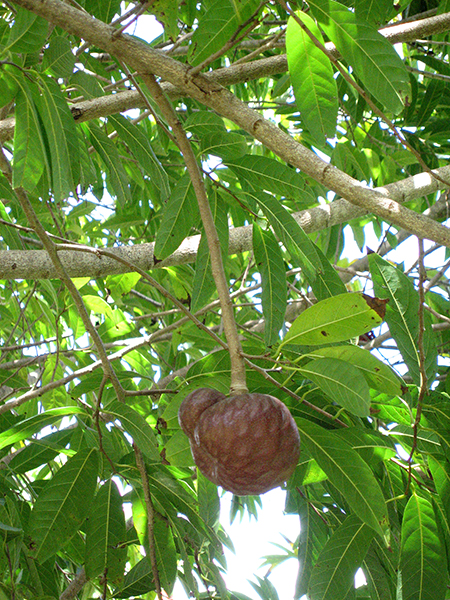Tropical Plant Database - Plant Details
Annona reticulata
Click on any heading above to view more information about this plant
Conservation Status
- IUCN: least concern
- USFWS: None
Family: ANNONACEAE
Genus: Annona
Species: reticulata
Species Author: L.
Vernacular: Custard Apple, Bullock's Heart
Genus: Annona
Species: reticulata
Species Author: L.
Vernacular: Custard Apple, Bullock's Heart
The Custard Apple is an erect tree with a spreading crown and 10 to 14 in (25-35 cm) thick trunk. The leaves are deciduous, alternate, oblong or narrow-lanceolate with visible veins and have a bad smell. The flowers that never fully open, appear in drooping clusters and they are fragrant and slender, with 3 outer fleshy, narrow petals, light-green externally and pale-yellow with a dark-red or purple spot on the inside at the base. The compound fruit is 3 l/4 to 6 1/2 in (8-16 cm) in diameter and can be symmetrically heart-shaped, lopsided, irregular, nearly round, or oblate with a deep or shallow depression at the base. The skin of the fruit is thin but tough and can be yellow or brownish when ripe, with a pink, reddish or brownish-red blush. There is a thick, cream-white layer of custard like flesh beneath the skin surrounding the juicy segments. In each segment there is a single, hard, dark-brown or black, glossy seed, oblong and smooth, less than a half of inch long. There are between 55 and 76 seeds in a fruit. The ripe fruit is sweet and pleasant in flavor. The unripe fruit is rich in tannin.
(Morton, J. 1987. Fruits of Warm Climates.)
(Morton, J. 1987. Fruits of Warm Climates.)
A root decoction is taken as a febrifuge, while fragments of the root bark are packed around the gums to relieve toothache. The bark is very astringent and the decoction is taken as a tonic and also as a remedy for diarrhea and dysentery.
The leaf decoction is given as a vermifuge. Crushed leaves or a paste of the flesh may be poulticed on boils, abscesses and ulcers.
The unripe dried fruit dried is employed against diarrhea and dysentery. In severe cases, the leaves, bark and green fruits are all boiled together for 5 minutes in a liter of water to make an extremely potent decoction.
(Morton, J. 1987. Fruits of Warm Climates.)
The leaf decoction is given as a vermifuge. Crushed leaves or a paste of the flesh may be poulticed on boils, abscesses and ulcers.
The unripe dried fruit dried is employed against diarrhea and dysentery. In severe cases, the leaves, bark and green fruits are all boiled together for 5 minutes in a liter of water to make an extremely potent decoction.
(Morton, J. 1987. Fruits of Warm Climates.)
The seed kernels are very toxic. The seeds, leaves and young fruits have insecticidal effect. The leaf juice kills lice. Sap from cut branches is acrid and irritant and can severely injure the eyes.
The bark contains 0.12% anonaine. Injection of an extract from the bark caused paralysis in a rear limb of an experimental toad.
(Morton, J. 1987. Fruits of Warm Climates.)
The bark contains 0.12% anonaine. Injection of an extract from the bark caused paralysis in a rear limb of an experimental toad.
(Morton, J. 1987. Fruits of Warm Climates.)
The leaves have been employed in tanning and they yield a blue or black dye. A fiber derived from the young twigs is superior to the bark fiber from Annona squamosa, the Sugar Apple.
Custard Apple wood is yellow, soft, fibrous but durable, moderately close-grained and it has been used to make yokes for oxen.
(Morton, J. 1987. Fruits of Warm Climates.)
(Information for this species compiled and recorded by Camelia Cirnaru, NTBG Consultant.)
Custard Apple wood is yellow, soft, fibrous but durable, moderately close-grained and it has been used to make yokes for oxen.
(Morton, J. 1987. Fruits of Warm Climates.)
(Information for this species compiled and recorded by Camelia Cirnaru, NTBG Consultant.)
The Custard Apple is believed to be a native of the West Indies but it was carried in early times through Central America to southern Mexico. While in Hawaii it is not well known, it is commonly grown in the Bahamas and occasionally in Bermuda and southern Florida.
(Morton, J. 1987. Fruits of Warm Climates.)
(Morton, J. 1987. Fruits of Warm Climates.)
In India, the fruit is eaten only by the lower classes, out-of-hand but Central America, Mexico and the West Indies, the fruit is appreciated by all. When fully ripe the fruit is soft to the touch and the stem and attached core can be easily pulled out. The flesh may be scooped from the skin and eaten as it is or served with light cream and sugar. Often is added to milk shakes, custards or ice cream.
(Morton, J. 1987. Fruits of Warm Climates.)
(Morton, J. 1987. Fruits of Warm Climates.)
- 030995 - collected by John D. Dwyer in 1973
- 043314 - collected by F. R. Fosberg in 1980
- 019708 - collected by David H. Lorence in 1995
- S062120 - collected by David H. Lorence in 1995
- 039614 - collected by David H. Lorence in 2003
- 042252 - collected by Steve Perlman in 2004
We currently have 6 herbarium specimens for Annona reticulata in our collection. Click on any specimen below to view the herbarium sheet data.
.svg)












